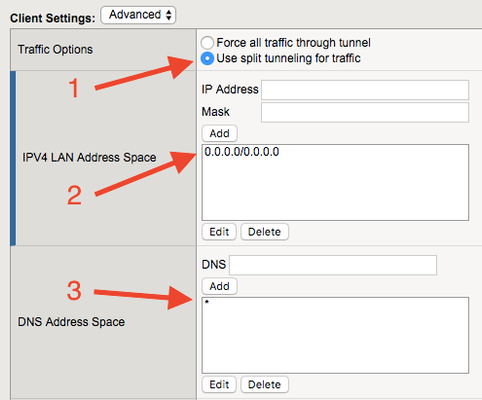split tunneling
3 TopicsSSL VPN Split Tunneling and Office 365
UPDATE: Apr 9, 2020 A colleague, Vinicius M. , put together a Configuration guide: Optimizing Office 365 traffic on Remote Access through VPNs when using BIG-IP APM.pdf As we shift to a much larger remote workforce than ever before, additional strains are being placed on the remote access infrastructure of many organizations around the world. Over the past several weeks we have seen organizations adapt quickly, and as it relates to APM, implement split tunneling configurations to specifically allow Office 365 traffic to egress a client's local interface instead of the corporate network via the VPN tunnel. Microsoft publishes their Office 365 endpoints (URLs & IPs) via an API but occasionally they make changes and keeping on top of those changes can be an administrative nightmare. To make the ongoing maintenance of the Network Access Lists / split tunneling configuration as seamless as possible, I’ve adapted a Python script (see GitHubRepo) we commonly use for SSL Orchestrator deployments to fetch Office 365 endpoints and update one or more Network Access Lists. Used in conjunction with iCall, this script will periodically check for and apply updates to your Network Access List(s) without any administrative intervention, allowing you to focus on other mission critical tasks. The script is maintained and documented in this GitHub repository: https://github.com/f5regan/o365-apm-split-tunnel Microsoft has provided us with a statement concerning their recommendations for Office 365 and split tunneling: "Microsoft recommends excluding traffic destined to key Office 365 services from the scope of VPN connection by configuring split tunneling using published IPv4 and IPv6 address ranges. For best performance and most efficient use of VPN capacity, traffic to these dedicated IP address ranges associated with Office 365 Exchange Online, SharePoint Online and Microsoft Teams (referred to as Optimize category in Microsoft documentation) should be routed directly, outside of the VPN tunnel. Please refer to Microsoft guidance for more detailed information about this recommendation." Microsoft’s recommendations have been incorporated into the script published in the aforementioned GitHub repository. See the changelog for details. More Resources In addition to considering how the steps in this article may relieve some strain on your organization’s remote access infrastructure, I’d highly recommend visiting How to optimize SSL VPN connections when BIG-IP is reaching 100% CPU for further guidance on optimizing SSL VPN connections.14KViews7likes19CommentsVPN BIG-IP Edge client : traffic over VPN tunnel with full or split tunneling
We have established a VPN connection between a Windows client and a BIGIP v15. We are using BIGIP Edge client, with network access. Full tunneling We do not really understand what kind of traffic is allowed or disallowed over the VPN tunnel. According to this document : https://techdocs.f5.com/kb/en-us/products/big-ip_apm/manuals/product/apm-network-access-13-0-0/2.html with full tunneling "all traffic (including traffic to or from the local subnet) is forced over the VPN tunnel." How traffic to local subnet can be forced over the VPN tunnel ? Does full tunneling ensure that the resource is not leaking traffic to the client's LAN ? Split tunneling In order to use split tunneling, we have to fill the field "IPV4 LAN Address Space", to specify a list of addresses. Only the traffic to these addresses goes through the tunnel configured for Network Access, all other traffic bypasses the tunnel. As this field is mandatory, what is the purpose of the field "Exclude Address Space" (not mandatory) ? What is the purpose of the feature "split by DNS" ? How to know if it is better to use "split by DNS" instead of "split by IP" ?1KViews0likes1CommentF5 APM VPN Support For Microsoft O365 Split-Tunneling
We ran into a significant issue with remote VPN client performance when our Microsoft Office products moved to the O365 cloud offering. Our current limitation of "no split-tunneling" per corporate policy, prevented our users from establishing connectivity to their geographically preferable O365 cloud. Instead, their traffic could/would route back to the corporate F5 APM VPN BigIP and then out to the internet. Much longer path and real-time services such as Teams/Skype calls suffered greatly. Other vendors were also having issues with this such as ForcePoint (Websense) and McAfee. Those vendors released O365 specific patches to permit a better performance through various rules and methods. Our F5 APM VPN was the bottle-neck and we had to address this quickly. Approval was granted to permit ONLY O365 products to be split-tunneled. Luckily, Microsoft has fielded this question/requirement many times and they had a ready answer: https://docs.microsoft.com/en-us/office365/enterprise/urls-and-ip-address-ranges Unfortunately, there's +500 IPv4 networks alone. Many are overlapping and some could be combined into a supernet. Not pretty, but workable. Using node.js, we developed a script that will pull-down the Microsoft IPv4 space, perform a CIDR clean on the networks, log into the F5 BigIP and push the Network Access exclude IP list, then apply the Access Policy in one shot. You can see the repo here: https://github.com/adamingle/f5O365SplitTunnelUpdateScript If you'd like to use the repo, please note the "settings.json" file. You will need to update according to the README.md Additionally, you will need to configure the allowable/tunneled traffic for the Network Access on VPN. If you only specify the exclusion space, there will be no inclusion space and no traffic will traverse the tunnel. Enable split-tunneling by checking the "Use split tunneling for traffic" radio button Add ALL networks to the "IPV4 LAN Address Space" with the IP Address 0.0.0.0 and Mask 0.0.0.0 Specify wildcard/asterisk for the "DNS Address Space" After you have the split-tunneling enabled on your Network Access Lists in F5 APM and you have correctly modified the "settings.json" file of your local f5O365SplitTunnelUpdateScript repo, you should be able to execute your O365 split-tunneling address exclusion changes. Use Jenkins or other automation tool to run the script automatically. Definitely worth a watch: https://channel9.msdn.com/Events/Ignite/2015/BRK3141 *This has been tested/used successfully with the Edge 7.1.7.1 client on v13.1.11.8KViews2likes7Comments
